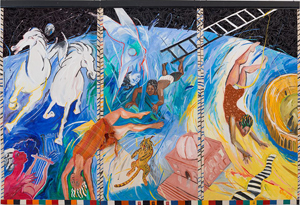11.20.23 — A Family Odyssey
Allow me to use a holiday week to catch up with some posts that never made it to the blog. It has been a busy fall. When the Philadelphia Museum of Art called Emma Amos in retrospective “Color Odyssey,” it meant hers, of course, as a woman of color and an artist. Still, nothing for Amos is just about her.
It is about friends, and the museum went big on her portraits. It is about family and race, and ten monoprints follow them both from the end of slavery to the present. Now in Chelsea, that series is about western culture as well, black and white, and she named it after a truly classical legacy, The Odyssey. Do not be shocked, though, if it concludes with her. 
Amos created Odyssey in 1988 for a museum in Atlanta, the city of her family. A series that begins with an open book by Zora Neale Hurston (a family friend) cannot be just about her—although it contains her personal mark-up, in red pen. But then her family made history. Her grandfather became the state’s first black pharmacist, and a spread from The Dixie Pharmaceutical Journal (ouch) shows him amid white professionals, who made a pilgrimage to see him. Her father took up his father’s business, and her mother, with a degree in anthropology, managed the store. Still, a black family knew exclusions, and it is up to the artist to make them visible and to set them free.
Just eighteen months after her retrospective, the series emerges for the first time in roughly thirty years—the first since it showed here in New York at the Studio Museum in Harlem. Its recovery cannot match her retrospective (and I shall leave a proper appreciation to my past review, so do take a look). It can, though, supply an enormous missing piece. Odyssey has the front room, so that the additional work, much of it from the same years, comes as context. It includes what she called “Falling Figures” and the gallery “Classical Legacies.” Still, the prints cannot help standing out, at Ryan Lee through September 9.
While the images are not life size, the prints sure are, with an overlay of paint and glitter. They can be as colorful as the early portraits in Philadelphia. Here, though, her colors shine brightest when casually applied. Photo transfers attest to a large family, seated and most at home with one another. In between, figures float freely in the indefinite space of memory. That includes Amos in a flowing dress, looking younger than her fifty years.
That spatial motif recurs often in paint, and so do the classics. Billie Holiday swims toward Leda and the swan. In the show’s largest painting, Flying Circus (also from 1988), acrobats command the sky while a swimmer goes deep, perhaps too deep. A singer plays the lyre, like Orpheus in myth, and white horses charge forward, as if at ancient Rome’s Circus Maximus, leaving their only rider behind. Two figures, black and white, stand in uneasy proximity on an imagined Grecian urn. Amos did start as an abstract painter, but who knew that the transition to realism would come in 1960 with coarse black marks after the ruins of Pompeii?
Amos spent due time in Europe. For her, though, the classics need be neither ancient nor white. Homer had his Odyssey, but then so did Romare Bearden, whom she knew well from Spiral, the African American collective. Then, too, it is hard to think of a black odyssey apart from the Great Migration—or the Migration Series by Jacob Lawrence. As James Joyce put it in Ulysses, “Longest way around is the shortest way home.” Amos is always heading home.
She may be dense with allusions, but not as a burden on the viewer. By the very nature of memory, one need not pin them down. They float freely much like her colors, between high and low culture and between real and imagined space. The next-to-last print in Odyssey contains cop cars and the KKK, and her ancestors surely knew them both all too well. Yet she ends hopefully with Freedom March—here not a collective act, but Muhammad Ali standing alone. The artist herself is walking her dogs and striding high.
Read more, now in a feature-length article on this site.